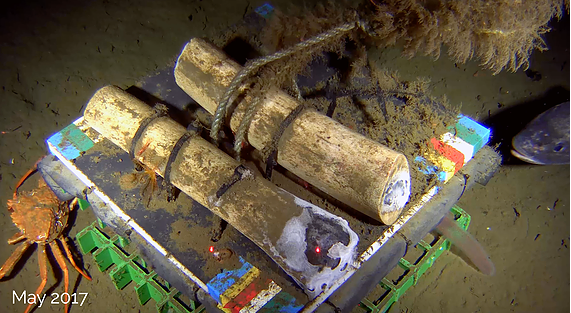SubC Geschichten: Wal-Knochen-Studie wird im Barkley Canyon mit Unterwasser-Kamera-Observatorium fortgesetzt
Monitoring how benthic organisms utilize the sparse food resources available in deep-sea settings
Permanent presence on the seafloor allowing for long-term observation
Thanks to SubC Imaging’s Observatory System, researchers are able to establish large-scale patterns of biodiversity and ecosystem function
Led by Professor Craig Smith (University of Hawaii at Manoa), Professor Lisa Levin (Scripps Institution of Oceanography), and Dr. Fabio De Leo (Ocean Networks Canada), the University of Victoria have been using SubC’s Observatory Solution for their underwater study in Barkley Canyon since 2014.
In May 2014, three humpback whale (Megaptera novaeangliae) rib sections, one 20x20x10 block of Douglas Fir (Pseudotsunga meniziesi), and a ~ 30x30x30 block of authigenic carbonate were placed at a depth of 890m inside the Barkley Canyon -- a site at Ocean Networks Canada NEPTUNE subsea camera observatory. The purpose of this scientific experiment is to monitor the changes triggered by the implantation of various organic and inorganic substrates as well as monitor how benthic organisms utilize the sparse food resources available in deepsea settings.
Full Control of Deep-Sea Observations
Die im Zeitraffervideo des Barkley Canyon gezeigten Aufnahmen stammen von einer neueren Generation von SubC-Smart-Kameras, auf die die Universität von Victoria während des Projekts aufgerüstet hat.
Alle zwei Stunden schwenkten die autonomen Unterwasserkameras und LEDs zu den drei Substraten und nahmen fünfminütige Videos auf, während sie ihre Position für jeweils eine Minute hielten.
"Dies ist das erste Mal, dass wir in der Lage sind, unsere Beobachtungen in tiefem Wasser zu kontrollieren, indem wir die Experimente täglich alle zwei Stunden aufzeichnen und das Licht jederzeit einschalten können, um weitere Beobachtungen zu machen." - Dr. Fabio De Leo
Cost Efficient, Long-Term Observation
Setting up a cabled ocean observatory created a permanent presence on the seafloor allowing for long-term observation. This also eliminated the need for costly, more time-consuming monitoring via multiple deployments of ROVs or AUVs in order to gather the data. With the help of the Observatory Solution, the researchers are able to establish large-scale patterns of biodiversity and ecosystem function in areas where there are whale bones.
Referenzen
Zitierung: De Leo, Fabio & Smith, Craig R. & Levin, Lisa & Fleury, Aharon (2016). Early benthic successional processes at implanted substrates in Barkley Submarine Canyon affected by a permanent oxygen minimum zone, American Geophysical Union 2016. Bibcode: 2016AGUOSME34B0796C
Biodiversität, Konnektivität und Ökosystemfunktion in organisch reichen Walknochen- und Holzfallhabitaten im Barkley Canyon
https://www.oceannetworks.ca/whalebone-experiment-minimum-oxygen-zone
https://www.oceannetworks.ca/researcher-residence-craig-smith-whale-falls

